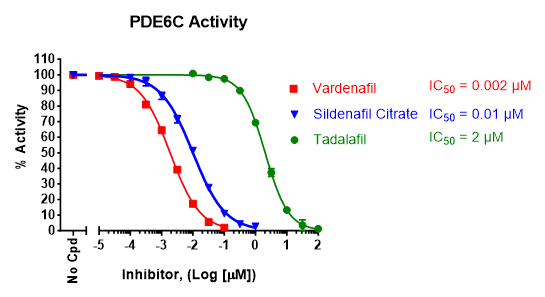PDE6C Assay Service
●
Target
PDE6C
●
Description
Screening and/or profiling inhibitor compounds against PDE6C phosphodiesterase activity in a biochemical assay.
●
Synonyms
phosphodiesterase 6C
●
Example Data

*Example only, final data may vary.
Assay Details
●
Assay Format
Fluorescence Polarization
●
Reference Compounds and IC50
Vardenafil, 0.002 μM; Sildenafil citrate, 0.01 μM; Tadalafil, 2 μM
●
Assay Principle
The PDE6C Assay is designed for identification of PDE6C inhibitors using fluorescence polarization. The assay is based on the binding of a fluorescent nucleotide monophosphate generated by PDE6C to the binding agent. Phosphodiesterases catalyze the hydrolysis of the phosphodiester bond in dye-labeled cyclic monophosphates. Beads selectively bind the phosphate group in the nucleotide product. This increases the size of the nucleotide relative to unreacted cyclic monophosphate. In the polarization assay, dye molecules attached to the rapidly-rotating cyclic monophosphates will emit light with low polarization while dyes attached to the slowly-rotating nucleotide-bead complexes will emit highly polarized light. The ratio of polarized to non-polarized light is therefore linearly correlated with PDE activity.
Target Details
●
Protein Family
Phosphodiesterases
●
UniProt
P51160
●
Background
Phosphodiesterases (PDEs) play an important role in dynamic regulation of cAMP and cGMP signaling. In particular, PDE6C, also known as cGMP-inhibited phosphodiesterase, is involved in light detection and cone phototransduction. PDE6C encodes the alpha-prime subunit of cone-specific phosphodiesterase, an enzyme found exclusively in the light-detecting (photoreceptor) cells called cones. Cone cells are found in a specialized tissue at the back of the eye known as the retina, and mutations in PDE6c are associated with eye diseases including Cone Dystrophy 4 and Achromatopsia.
Delivery
●
Estimated Turnaround
Two to three weeks following delivery of compounds
●
Results
Extensive report with raw and analyzed data, graphs, and detailed protocols. Includes positive control for inhibition.

